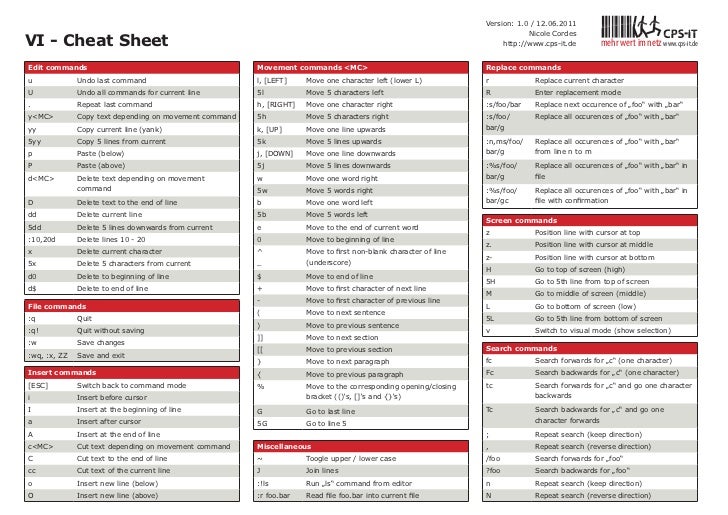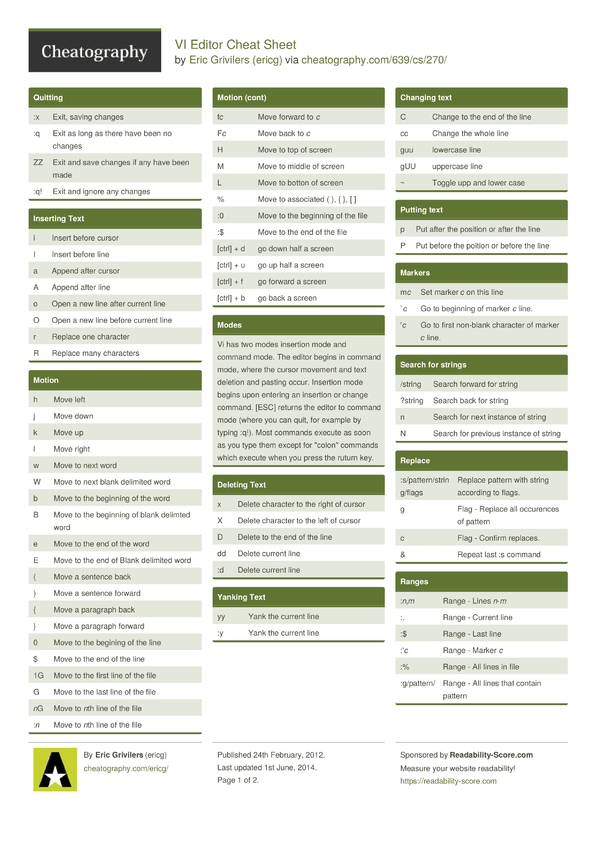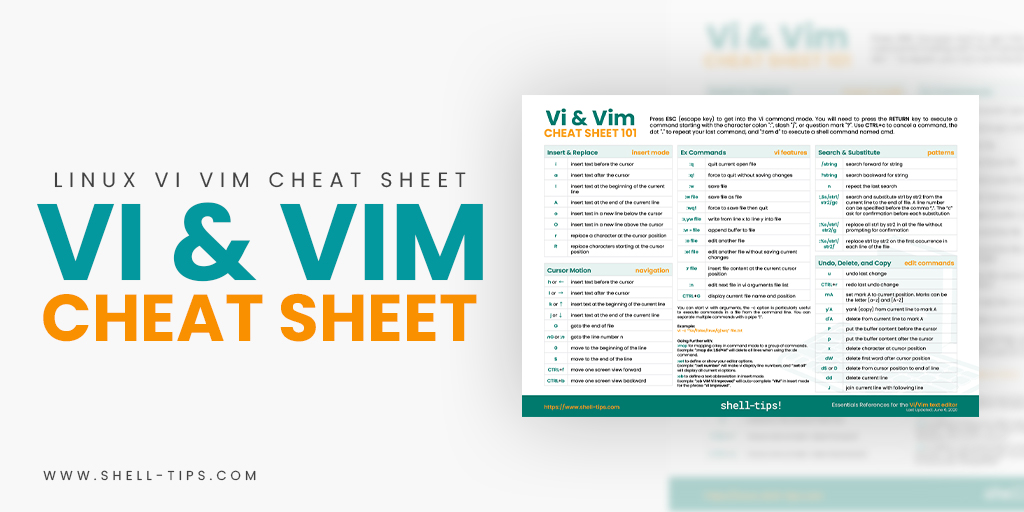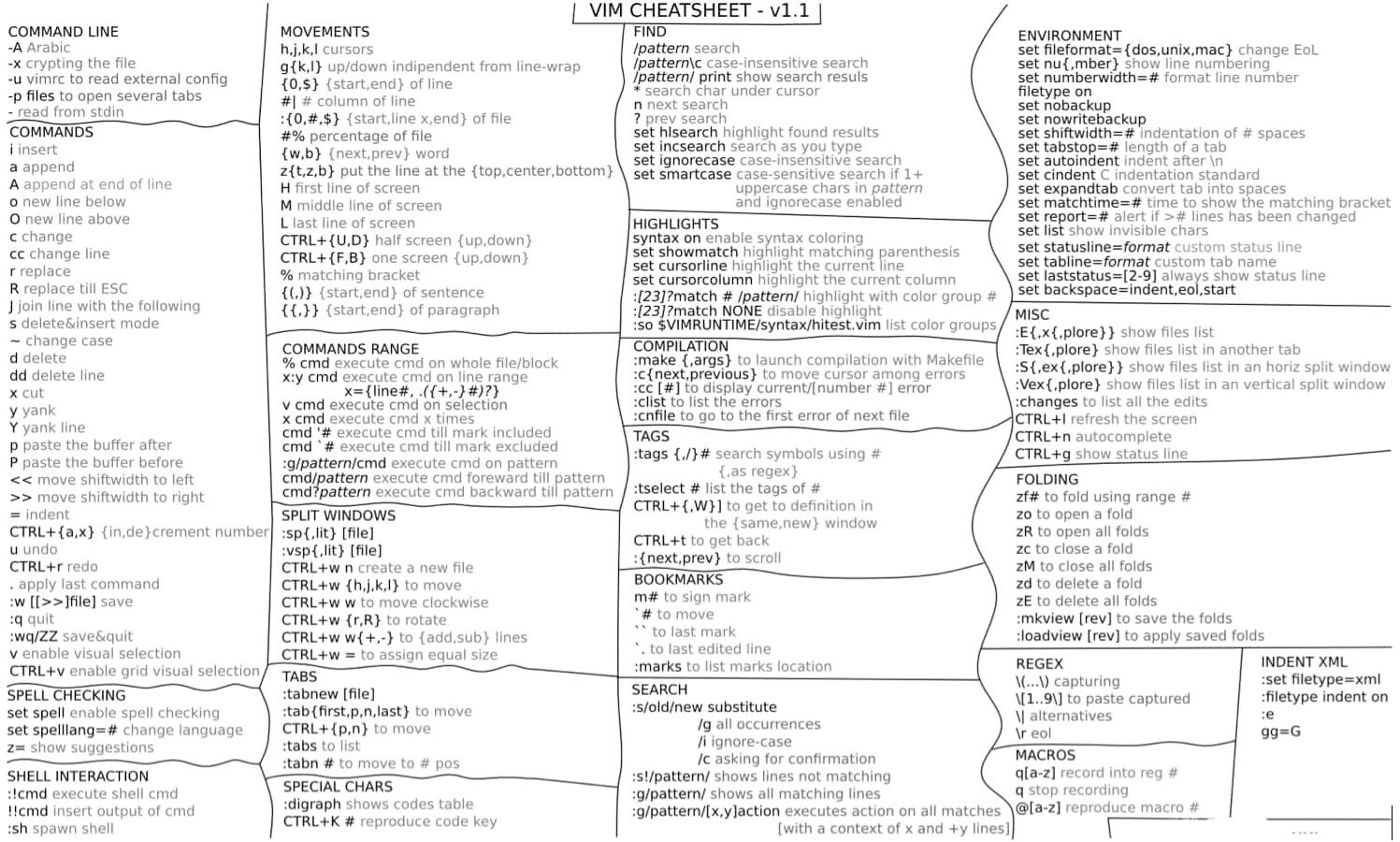- Vi Editor Commands Pdf
- Vi Help Sheet
- How To Use Vi
- Vi Commands Cheat Sheet
- Linux Vi Commands Cheat Sheet
- Vi Commands Cheat Sheet Pdf
Thousands of people use such cheat sheets for various programming languages and/or tools that give them a quick reference to commonly used steps/commands. Trust me, using cheat sheets among the best practices advised to programmers. This Vi cheat sheet will help you a lot if you are just starting with Vi or if you infrequently use the Vi editor. Vs2013 community edition iso. VI “Cheat” Sheet ACNS Bulletin ED–03 February 1995 File management commands:w name Write edit buffer to file name:wq Write to file and quit:q! Quit without saving changes ZZ Same as:wq:sh Execute shell commands (d) Window motions d Scroll down (half a screen) u Scroll up (half a screen) f Page forward b Page backward. VI Commands Cheat Sheets Before doing anything to a document, type the following command followed by a carriage return::set showmode GOOD PRACTICE NOTE ESPECIALLY FOR BEGINNERS: WHEN USING VI, HIT ESC TWICE BEFORE EVERY NEW COMMAND. The expression means that you should enter a command, means that you should enter a filename, and means that you should enter a character or number. The symbol ^ (caret) means that you should hold down the Ctrl key while pressing the indicated letter. Vi editor command keys. This cheat sheet is intended to be a quick reminder for the main concepts involved in using the command line program Vim (or vi) and assumes you already understand its usage. It does not cover every command in Vim, only the ones we consider to be useful for most people for the majority of their text editing.
The vi editor is a command-line, interactive editor that you can use to create and modify text files. The vi editor is also the only text editor that you can use to edit certain system files without changing the permissions of the files. The Vim editor is an enhanced version of the vi editor.
Accessing the vi Editor
To create, edit, and view files in the vi editor, use the vi command. The vi command includes the following three syntaxes:
If the system crashes while you are editing a file, you can use the -r option to recover the file.
The file opens so that you can edit it. You can then save the file and exit the vi editor, by using the following command:
The file opens in read-only mode to prevent accidental overwriting of the contents of the file.
The vi Editor Modes
The vi editor provides three modes of operation:
1. Command mode – The command mode is the default mode for the vi editor. In this mode, you can run commands to delete, change, copy, and move text. You can also position the cursor, search for text strings, and exit the vi editor.
2. Input mode – You can insert text into a file in the input mode. The vi editor interprets everything you type in the input mode as text. To invoke input mode, press one of the following lowercase keys:
- i – Inserts text before the cursor
- o – Opens a new blank line below the cursor
- a – Appends text after the cursor
Vi Editor Commands Pdf
You can also invoke the input mode to insert text into a file by pressing one of the following uppercase keys:
- I – Inserts text at the beginning of the line
- O – Opens a new blank line above the cursor
- A – Appends text at the end of the line
3. Last line mode – You can use advanced editing commands in the last line mode. To access the last line mode, enter a colon (:) while in the command mode. Entering the colon (:) character places the cursor at the bottom line of the screen.
Switching Between Modes
– The default mode for the vi editor is the command mode.
– To switch to the input mode, press i, o, or a.
– To return to the command mode, press the Escape key.
– In the command mode, you can save the file and quit the vi editor, and return to the shell prompt.
Viewing Files in the Read-Only Mode
The view command enables you to view files in the read- only mode.
Vi Help Sheet
The view command invokes the vi editor in the read-only option, which means you cannot save changes to the file. For example, to view the data.txt file in the read-only mode, enter the following command:
The data.txt file appears. Enter the :q command to exit the file, exit the vi editor, and return to the shell prompt.
Moving the Cursor Within the vi Editor
The table shows the key sequences that move the cursor. Telecharger any video converter professional.
| Key Sequence | Cursor Movement |
|---|---|
| h, left arrow, or Backspace | Left one character |
| j or down arrow | Down one line |
| k or up arrow | Up one line |
| l, right arrow, or space bar | Right (forward) one character |
| w | Forward one word |
| b | Back one word |
| e | To the end of the current word |
| $ | To the end of the line |
| 0 (zero) | To the beginning of the line |
| ^ | To the first non-white space character on the line |
| Return | Down to the beginning of the next line |
| G | Goes to the last line of the file |
| 1G | Goes to the first line of the file |
| :n | Goes to Line n |
| nG | Goes to Line n |
| Control + F | Pages forward one screen |
| Control + D | Scrolls down one-half screen |
| Control + B | Pages back one screen |
| Control + U | Scrolls up one-half screen |
| Control + L | Refreshes the screen |
| Control + G | Displays current buffer information |

Inserting and Appending Text
The table describes the commands to insert and append text to a new or existing file by using the vi editor.
| Command | Function |
|---|---|
| a | Appends text after the cursor |
| A | Appends text at the end of the line |
| i | Inserts text before the cursor |
| I | Inserts text at the beginning of the line |
| o | Opens a new line below the cursor |
| O | Opens a new line above the cursor |
| :r filename | Inserts text from another file into the current file |
Text-Deletion Commands


The table shows commands that delete text in the vi editor.
| Command | Function |
|---|---|
| R | Overwrites or replaces characters on the line at and to the right of the cursor. To terminate this operation, press Escape. |
| C | Changes or overwrites characters from the cursor to the end of the line |
| s | Substitutes a string for a character at the cursor |
| x | Deletes a character at the cursor |
| dw | Deletes a word or part of the word to the right of the cursor |
| dd | Deletes the line containing the cursor |
| D | Deletes the line from the cursor to the right end of the line |
| :n,nd | Deletes lines n -n (For example, :5,10d deletes lines 5-10.) |
You can use numerous commands to edit files by using the vi editor. The following sections describe basic operations for deleting, changing, replacing, copying, and pasting. Remember that the vi editor is case-sensitive.
Edit Commands
The table describes the commands to change text, undo a change, and repeat an edit function in the vi editor.
How To Use Vi
| Command | Function |
|---|---|
| cw | Changes or overwrites characters at the cursor location to the end of that word |
| r | Replaces the character at the cursor with one other character |
| J | Joins the current line and the line below |
| xp | Transposes the character at the cursor and the character to the right of the cursor |
| ~ | Changes letter casing to uppercase or lowercase, at the cursor |
| u | Undoes the previous command |
| U | Undoes all changes to the current line |
| . | Repeats the previous command |
Search and Replace Commands
The table shows the commands that search for and replace text in the vi editor.
| Command | Function |
|---|---|
| /string | Searches forward for the string |
| ?string | Searches backward for the string |
| n | Searches for the next occurrence of the string. Use this command after searching for a string. |
| N | Searches for the previous occurrence of the string. Use this command after searching for a string. |
| :%s/old/new/g | Searches for the old string and replaces it with the new string globally |
Copy and Paste Commands
The table shows the commands that cut, copy, and paste text in the vi editor.
| Command | Function |
|---|---|
| yy | Yanks a copy of a line |
| p | Puts yanked or deleted text under the line containing the cursor |
| P | Puts yanked or deleted text before the line containing the cursor |
| :n,n co n | Copies lines n -n and puts them after line n (For example, :1,3 co 5 copies lines 1-3 and puts them after line 5.) |
| :n,n m n | Moves lines n -n to line n. For example, :4,6 m 8 moves lines 4-6 to line 8, line 6 becomes line 8, line 5 becomes line 7, and line 4 becomes line 6. |
Save and Quit Commands
The table describes the commands that save the text file, quit the vi editor, and return to the shell prompt.
| Command | Function |
|---|---|
| :w | Saves the file with changes by writing to the disk |
| :w new_filename | Writes the contents of the buffer to new_filename |
| :wq | Saves the file with changes and quits the vi editor |
| :x | Saves the file with changes and quits the vi editor |
| ZZ | Saves the file with changes and quits the vi editor |
| :q! | Quits without saving changes |
| ZQ | Quits without saving changes |
Session Customization
You can customize a vi session by setting variables for the session. When you set a variable, you enable a feature that is not activated by default. You can use the set command to enable and disable variables. The set command variables include displaying line numbers and invisible characters, such as the Tab and the end-of-line characters.
To create an automatic customization for all your vi sessions, perform the following steps:
- Create a file named .exrc in your home directory.
- Enter any of the set variables into the .exrc file.
- Enter each set variable without the preceding colon.
- Enter each command on one line.
The vi editor reads the .exrc file located in your home directory each time you open a vi session, regardless of your current working directory.
Session Customization Commands
Vi Commands Cheat Sheet
The table describes some of the variables of the set command.
Linux Vi Commands Cheat Sheet

Vi Commands Cheat Sheet Pdf
| Command | Function |
|---|---|
| :set nu | Shows line numbers |
| :set nonu | Hides line numbers |
| :set ic | Instructs searches to ignore case |
| :set noic | Instructs searches to be case-sensitive |
| :set noic | Displays invisible characters, such as ^I for a Tab and $ for end-of-line characters |
| :set nolist | Turns off the display of invisible characters |
| :set showmode | Displays the current mode of operation |
| :set noshowmode | Turns off the mode of operation display |
| :set | Displays all the vi variables that are set |
| :set all | Displays all vi variables and their current values |
